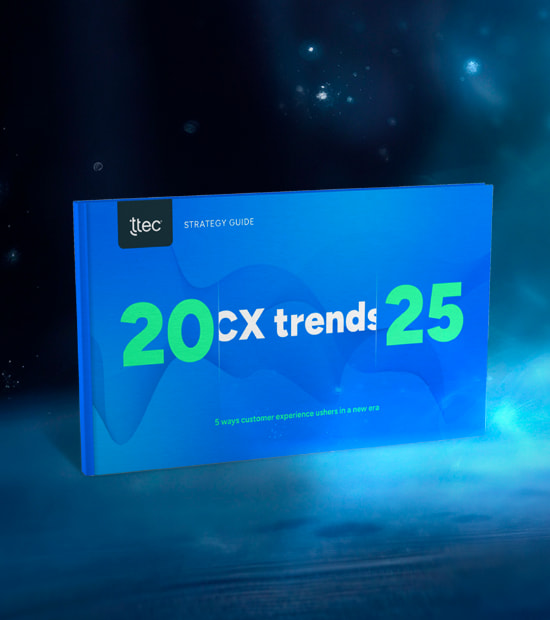Everybody wants contented customers. They’re profitable, loyal advocates who evangelize the brand to help drive growth.
When they’re on tenterhooks, however, as banking consumers are right now, there’s risk but also opportunities that will pay dividends long after today’s anxiety lifts. Assist someone in a time of need and they’re forever grateful.
Banks and financial institutions recognize customers are nervous at this time, so they’re fortifying the contact center and empowering front-line associates to ease financial fears. Proactive outreach, innovative technologies, and a flexible workforce form the tactical trifecta, as discussed during a recent webinar, “Unlock peace of mind with proven CX in banking,” part of TTEC’s Meet the Moment LinkedIn Live series.
Financial health and security is as important to consumers as their own personal health.
“I don’t think you can have personal health without financial well-being,” said webinar panelist Carol Kemp, vice president, BFSI GTM leader, TTEC. “Customers want to feel safe. They want to feel protected, and they want a personal experience. Banking is personal.”
3 antidotes for financial angst
Nervous banking customers are often blind to the source of their anxiety. Uncertainty is fatiguing because it’s vague and ever-present. It’s here that banks with proactive outreach strategies distinguish themselves in the market — in both the short and long term.
“One key area driving a lot of uncertainty, stress, and concern for customers is deposits, the instability of banks,” said panelist Kristen Hein, group vice president, financial services, TTEC. “Bank failures like Silicon Valley Bank are causing concern, as well as consumer debt that’s back on the rise. This drives a lot of anxious inquiries into the bank.”
Antidote: Outbound excellence
To assuage customer concerns, forward-thinking banks don’t wait for those inquiries to flow in. Instead, they’ll anticipate and address them using a scalable outbound outreach program that leverages predictive analytics, customer journey mapping, training, A/B testing, and continuous improvement.
These tools enable banks to analyze customer intents in various channels, reduce friction across all interactions so the experience is optimized, and to identify customers at risk of defection, delinquency or collections.
With student loan forgiveness now in the hands of the Supreme Court, many consumers wonder if they’ll need to resume payments this fall, and that’s a source of stress.
“I think the way to get ahead of that with the outbound experience is with reminders,” said Hein. Banks can reach out to customers at risk to miss payments to encourage enrollment in autopay. Such simple steps create engagement that will forestall delinquency, helping customers avoid extra fees and penalties.
Kemp said outbound excellence can be as easy as reaching out to consumers at risk for churn, to proactively offer new services they’re unaware will benefit them. Access to a broad array of options is another means to calm nervous banking consumers.
Helping consumers before they reach out on their own not only builds trust but improves contact center operations through predictability and efficiency.
Antidote: AI with humanity
Proactive interactions between associates and customers are enhanced with the help of artificial intelligence, provided it’s balanced with a human touch.
AI-powered chatbots, for example, can handle simple inquiries that allow associates to focus on the more complex interactions requiring human care and understanding. However, some organizations are leery because they don’t know how to deploy chat and need an expert partner to guide them.
Banking is inherently fraught with emotional ups and downs. Consumers feel pressure to make important decisions in good times of prosperity as well as in times of financial hardship. AI-powered training helps refine emotional intelligence skills so associates can engage with customers with genuine empathy.
“There's a real shift in leveraging AI to deliver training in more automated and real-time ways, benefiting both employee retention and employee acquisition, which is super critical,” said Kemp.
Compassion bots conduct role-playing exercises so associates can practice handling emotionally charged customer interactions before they advance to live calls with customers. The bots then deliver real-time feedback and coaching so best practices become second nature. In a similar vein, objections bots used in training help associates master their skills managing customer resistance or agitation—with respect and empathy.
“It’s about empowering associates to have that emotional intelligence to help the financial wellness of your customers,” said Hein.
Antidote: Flexible staffing
Contact center employees value flexibility and there’s new ways to accommodate their desire for work-life balance. With TTEC’s FlexEX contact center model, associates have more control to manage and adjust their own work schedules. For banks, the model widens the talent pool to include a broader range of employees, from part-timers and students to those with limited mobility or access to transportation who are unable to report to an on-site workplace.
A flexible staff model enables banks and financial institutions to easily ramp up quickly when volume spikes and ramp back down as needed. Offshore and nearshore business process outsourcing is heating up.
More details about incorporating outbound excellence, AI, and flexible staffing into your contact center model are outlined in this Strategy Guide, “Ease nervous customers with rock-solid customer support.”
“We're seeing the labor shift to nearshore,” said Hein. “Our neighbors to the south offer a great opportunity for first-time outsourcers to get the talent down in Mexico. And it gives a comfort level for those looking to offshore not too far away, while getting a handle on cost containment delivering the basics.
Both Hein and Kemp underscored the importance of understanding where customers are in their journey and their preferred communications channels so interactions can be personalized and proactive.
“It goes back to leveraging AI to identify those customers so you’re not having to be reactive in the moment,” Kemp said. “Instead, you’re getting ahead of that customer sentiment.”
View the “Unlock peace of mind with proven CX in banking” on-demand webinar.
Peace of mind and banking are not mutually exclusive
In times of uncertainty, consumers welcome empathetic interactions with knowledgeable contact center associates

















